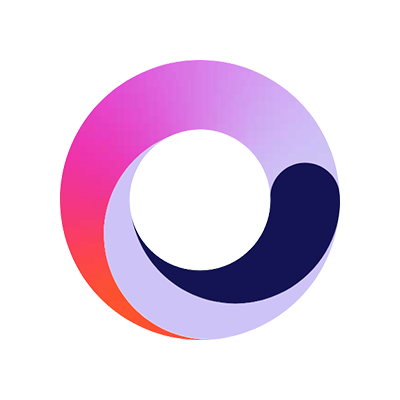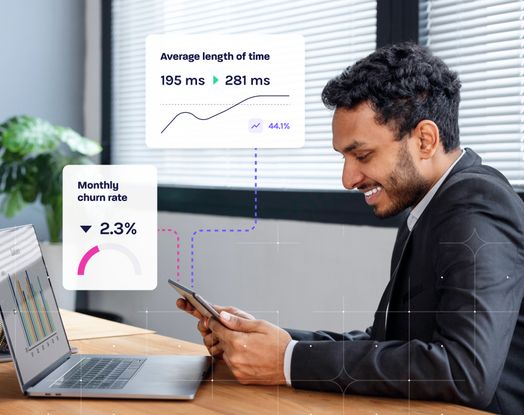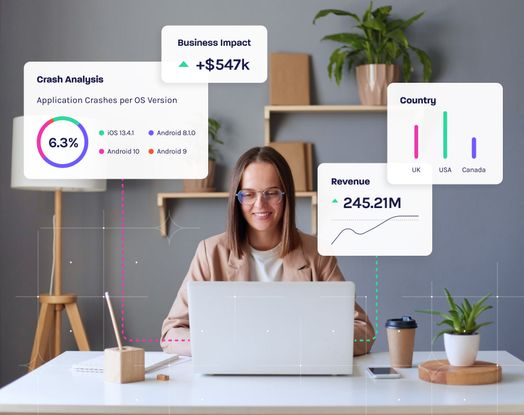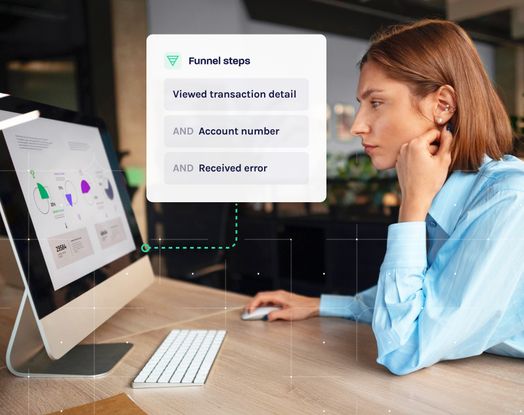
Click tracking: The ultimate guide to tracking website and app clicks
What is click tracking?
Click tracking is a type of analytics that measures and records user click events on a variety of digital channels. Through click tracking, you can get a breakdown of each type of click activity, providing a detailed analysis of user behavior. These insights help marketing and other teams determine the effectiveness of the channel design, copy, CTAs and other elements to inform decision-making for better conversion performance.
Types of click tracking
User engagement is the lifeblood of any successful digital strategy, and click tracking tools play an important role in deciphering user behavior and interactions. Whether you’re interested in understanding how users navigate your website or app, optimizing content engagement or improving overall UX, click tracking offers valuable insights and actionable data. Click tracking tools are used primarily for three types of user engagement, which are:
UX for website/apps: Click tracking graphically shows visitor interactions on the page, such as where the person is clicking, page links and CTAs, as well as elements that aren’t clickable.
Email click tracking: This type of tracking measures subscriber engagement and actions, including how many recipients clicked on an email, how many unique links were clicked, frequency of clicks and other metrics.
Tracking link clicks: These types of links directly attribute clicks to specific marketing campaigns, A/B testing and traffic from other digital channels to determine conversions and ROI.
How does click tracking work for websites and web apps?
Click tracking tools record visitors' click behavior using software or tags. Clicking on a link, form field or CTA, as examples, automatically generates a report on the behavior with a tracking code. The data analytics for each of the click reports can be displayed numerically, visually or by individual sessions.
🔥Humble brag: Glassbox’s digital experience intelligence platform offers tagless data capture, so you can easily analyze any journey without any manual effort.
How does click tracking work for mobile devices?
On mobile devices like a phone or tablet, click tracking identifies and records taps, zooms and pinches. These movements indicate interaction with images, buttons, text and general app elements. These interactions are then sent to analytics platforms for analysis.
Click tracking tools for mobile devices provide critical insights into user engagement so businesses can better understand how visitors navigate and interact with their mobile interfaces. These insights help teams optimize mobile UX, resulting in increased conversions and overall customer satisfaction.
7 benefits of click tracking analytics
Adopting click tracking as part of your digital analytics strategy offers many benefits. In addition to understanding visitors and buyers at a deeper level, you can improve digital channel engagement, performance and, best of all, conversions. Let’s take a closer look at the benefits of click tracking analytics below.
Enhanced data Insights: Drilling down into the details of each user’s action or inaction and all behaviors on your site or app provides a more comprehensive picture of the overall customer experience. You’ll also have detailed metrics to share and collaborate with teams involved in CX.
Understand user engagement and interaction patterns: Tracking each action taken by potential buyers and customers on your website or app delivers rich insights about UX performance, which features are popular and time spent on each platform.
Identify popular and underperforming elements on webpages/apps: Click tracking allows you to explore which elements are successful and which aren’t. Discovering which CTAs and links resonate with users can be repeated on other digital channels as appropriate while modifying or removing elements that aren’t performing well.
Improved conversion rates: By understanding where your users are clicking or tapping, you can determine which promotions are performing best and which are performing poorly. If you’re conducting A/B testing as part of your conversion optimization efforts, click tracking data can both provide ideas for new tests and help measure the success of design changes.
Optimized call-to-action buttons and links: There are many factors that impact CTA conversions and link effectiveness. Click tracking offers insights to determine how color, copy, placement and other variables correlate to performance. It’s a valuable analytics source to test new and modified designs.
Ability to make data-driven decisions to increase conversions: Rather than relying on guesses or hunches, you’ll have a solid foundation for improvements and revisions to your website and app to increase conversions. Once reported, stakeholders can be confident to leverage insights for the user experience.
Find and fix UX errors: Identifying and understanding what’s not working is just as important in click tracking. You can find broken links, static CTAs and other errors causing friction so you can fix them fast before they cause problems for other users. This will also decrease bounce rates and increase website traffic.
Uses for click tracking and click analytics
Click tracking is an invaluable tool for marketing, product and UX and engineering teams, just to name a few, helping them enhance their digital strategies, user experiences and overall performance. Below are some common uses for click tracking and click analytics.
Conversion funnel analysis: Click tracking is an important tool to analyze the effectiveness of each stage in the conversion funnel and how to optimize it. It’s also a powerful tool for overall CRO efforts to learn about CTA placement, copy and other page and app variables that work to convert potential customers into buyers.
CTA optimization: Click tracking helps businesses optimize their CTAs with a detailed analysis of click-through rates and engagement. These analytics show how colors, copy, button shape and other element factors affect performance. Insights can be used to conduct tests or apply learnings on other pages.
Content engagement analysis: Click tracking supports your content marketing decisions when looking at user engagement for content deliverables. For example, if visitors frequently click on a specific product page, you may want to add more blog posts, eBooks or other relevant content for new conversion opportunities.
UX and website/app optimization: Analyzing which elements on the page or app are performing or underperforming helps make decisions about UX navigation and layout, including streamlining, revising or adding elements.
A/B testing and personalization: Click tracking is instrumental in A/B testing different variations of webpages or app interfaces. A solid data analysis for A/B testing is the foundation for experimenting with color, placement and other variables for audience segments to see how it affects clicks and conversions.
E-commerce optimization: Click tracking plays a vital role in e-commerce optimization. It helps businesses identify pain points on product pages, add-to-cart buttons and checkout steps to streamline the purchasing process.
User struggle identification/resolution: Click tracking goes even further with a digital experience intelligence (DXI) platform to quickly find the root cause of user struggles, such as dead clicks, rage clicks and other issues. Features like retrospective analysis let you track clicks on specific words, elements and buttons on the fly to pull in past data for deeper insights.
An introduction to click maps
A click map is a type of click tracking tool that uses a heatmap as a visual representation of activity areas and engagement with elements on a website or mobile app. It graphically shows what a potential buyer or customer is doing on the page and their interaction with the elements.
Check out our blog on click maps to learn more.
Drawbacks of click data in isolation
Click maps contain considerably more heatmap data than a heatmap alone. However, there are some big limitations, such as:
Lack of precision: Because dynamic heatmap mouse tracking is an older technology, it typically shows just colors–not data–so you won’t get a detailed data analysis. Heatmap visualization software relies on mouse tracking and eye tracking, which isn’t the complete customer experience when evaluating heatmap analytics.
Less accuracy: Heatmap analytics can skew the reality of the visitor experience since the person may or may not be looking at page elements they are hovering over. If the size of a web page changes and the buttons move, the colors won’t be accurately mapped to where users really clicked.
Not flexible: Today’s websites are dynamic, with different content displayed based on user behavior, such as tooltips. Heatmaps rely on manually configured page states for this, but a complex page can have infinite layouts, making it difficult to access many other analytics and limiting available insights.
Not mobile-friendly: Mobile device and app users navigate content differently than websites. They tap, zoom and pinch as they navigate around an app. Legacy heatmap software doesn’t have the functionality to track these interactions, so the data analysis is limited and potentially inaccurate.
The power of advanced insights from a digital experience intelligence platform
It’s clear that click tracking and click maps offer a quantitative data view, but a digital experience intelligence (DXI) platform like Glassbox provides a deeper analytics functionality. DXI combines several data sources—web, digital, product, technical performance and voice of customer—to form a single, comprehensive view of the customer journey. This gives you the ability to drill into individual components and examine how all the pieces fit together, helping you uncover why users behave the way they do.
For instance, click map software is often integrated with session replay so you can see the exact actions users take on your website or app. When paired with heatmaps or interaction maps (interaction maps are the next generation of heatmap tools), you can see a comprehensive view of the data.
Learn more about how Glassbox can help and get a demo today.
FAQs
1. What is click tracking?
Click tracking is a type of analytics that measures and records user click events on a variety of digital channels. Click tracking reports give a breakdown of each type of click activity, providing a detailed analysis to evaluate user engagement, behavior and conversions.
2. What are the three types of click tracking?
The first is click tracking for website/app UX, which shows visitor interactions on the page or app, such as CTA clicks and page links.
The second type is email click tracking, which measures subscriber actions, such as how many recipients clicked, unique clicks and other metrics.
Lastly, link click tracking, which attributes clicks to sources, such as a campaign, traffic source and A/B testing.
3. What are the benefits of click tracking?
Enhances your existing data insights for a more detailed view of a visitor and provides analytics for user engagement and interaction patterns.
Identifies high-performing and underperforming elements.
Helps increase conversion rates, delivers rich insights for improvements, and provides the groundwork for data-driven decisions.
4. How is click tracking used?
Conversion funnel analysis: Click tracking is essential to analyze the effectiveness of each stage in the conversion funnel and how to optimize it.
CTA optimization: Helps optimize CTAs with detailed analysis on click-through rates and engagement.
Content engagement analysis: Supports content marketing decisions by analyzing engagement for content deliverables, determining additions, removals and other changes.
UX and website/app optimization: Measures and records elements on the page or app that are performing or underperforming.
Optimizing CTA buttons and links: Delivers insights to determine how color, copy, placement and other variables correlate to performance.
A/B testing and personalization: Provides rich analytics for A/B testing to learn how changes affect user behavior and clicks or conversions.








